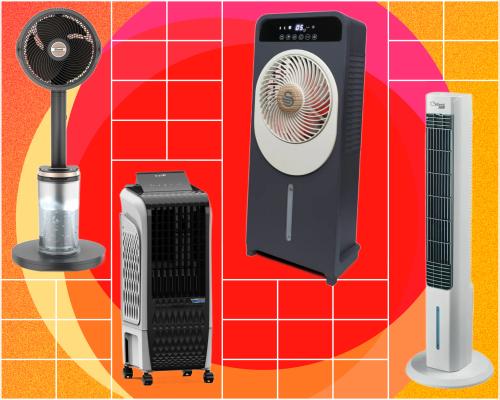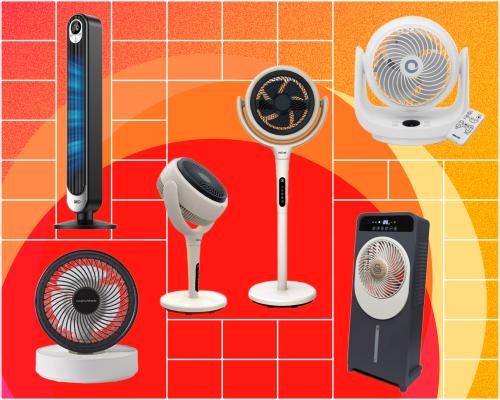
Air coolers are not the same thing as air conditioning. Rather than extracting moisture from the air to cool your room down by multiple degrees, evaporative coolers use water to cool the air they blow towards you – like a sea breeze taking the edge off summer heat – and they use a fraction of the electricity of aircon.
A typical portable air conditioner uses 1,000W (watts) of electricity (costing about 26p an hour to run, based on the current price cap). By comparison, the evaporative coolers I tested use between 26W and 87W; you could run my favourite model, the Swan Nordic (26W), for 38 hours and it would still use less electricity than a single aircon unit running for an hour.
When we’re suffering from heatwaves caused by the climate crisis, it makes sense to use less energy by choosing energy-efficient products that are effective and built to last. So I’ve tested eight air coolers to help find the best for you, assessing them in terms of size, noise, power use and, of course, how much they cool you down.
It’s worth considering a fan too: they don’t actively cool air down, but the improved air circulation they contribute helps your sweat to evaporate faster, cooling down your body – and they’re even more energy efficient. It’s a personal choice: a powerful fan feels immediately cooling, whereas an evaporative cooler actually lowers the temperature. Personally, I favour evaporative coolers that have powerful fans built in. Most can be used as stand-alone fans without the evaporative function enabled, although the effectiveness varies.
Note that evaporative coolers (sometimes known as swamp coolers) humidify your air, so they’re not a good fit if you have damp and mould problems. They’re designed to be used with doors open and fresh air coming in.
***
At a glance
-
Best air cooler overall:
Swan Nordic air cooler
£69.99 at Swan
-
Best budget air cooler:
JML Chillmax Air Tower Plus
£59.99 at Amazon
-
Best for cooling power:
Symphony Diet 3D 20i
£129 at Amazon
-
Best for the garden:
Shark FlexBreeze Pro Mist FA300UK
£219 at John Lewis
***
Why you should trust me
I’m triply qualified to test these evaporative coolers. First, I’m an award-winning consumer tech journalist with decades of experience testing gadgets of all shapes and sizes. Second, I have a degree in mechanical engineering. Last, but not least, I’m a menopausal woman in her 50s, as I pointed out while testing fans; I honestly can’t remember the last time I felt cold.
How I tested
I chose eight evaporative coolers, each from a different brand. For the scientific side of this test, I used a power meter to measure how much electricity (and therefore money and carbon) they use. From one metre away, I used a digital thermometer to measure the change in air temperature and the Sound Meter app to measure the noise. I also measured each evaporative cooler’s size.
Subjectively, I took note of everything from how cooling each evaporative cooler felt, how annoying the noise was and how easy the controls were to use. I also considered how they looked and how small they pack away for the winter, as well as the price tag.
Any evaporative coolers that weren’t collected by manufacturers were donated to Furnishing Futures, a charity that fully furnishes the empty social housing in which women and children are placed after surviving domestic abuse.
***
The best air coolers in 2025
***
Best air cooler overall:
Swan Nordic air cooler
£69.99 at Swan
Currently out of stock
This evaporative cooler isn’t just good-looking, it’s effective. I’ve tested it before for our fans test and retested it here: I found it just as good, and it came out slightly quieter in my tests this time. It’s on castors with a rear drawer for water, and comes with two ice packs to cool the water. There’s a slot to store the remote control.
Unusually, rather than oscillating or having a swing function, the grille at the front slowly turns to alter the breeze, which is a bit hypnotic.
Why we love it
The Swan cooled the room well, by 1C in an hour, and put out a wide, cooling breeze. There are 24 fan speeds, and you can select them via the remote control.
The breeze is powerful, and its energy consumption is modest. It’s great to use as a fan, with or without the evaporative cooling, depending on the temperature. It’s also one of the quietest on test; I could definitely sleep with it running.
It’s good value and good looking, with a coffee-coloured “oatmeal” finish and wood-effect detail. This makes a nice change from the monochrome of most models.
It’s a shame that … there’s no bung on the bottom for draining the tank at the end of summer. Instead, you have to use it until nearly empty, then tip it out – although this is only once a year.
Dimensions: 29 x 24 x 71cm (WDH)
Water tank: 5l
Number of speeds: 24
Remote control? Yes
Peak noise level on test: 40dB
Power use on top setting: 26W
***
Best budget air cooler:
JML Chillmax Air Tower Plus
£69.99 at B&Q £59.99 at Amazon
At its current lowest price of £59.99, this is a bit of a bargain – think of it as a tower fan with the added perk of evaporative cooling. It’s tall and thin, with a round base rather than castors. Indeed, the 29 x 29cm listed in the specs below includes the base, while the tower itself is just 15cm wide by 19cm deep.
It comes with an ice pack, and you can also take the grille off the front, remove the filter and pre-soak it (by running it under the cold tap) for faster cooling. I did this for the test, which may help explain why it was so effective. To fill it, you have to pour the water into the rear drawer with a jug; you can’t detach it. This means that emptying it requires you to tip it over the sink.
Why we love it
The JML cooler does a good job of putting out a cooling breeze, feeling almost like a tower fan. In fact, this cooler oscillates, turning from side to side, rather than having a swing function. Features include a timer (two, six, eight or 12 hours) and you can choose whether the lights are bright, dim or off – both features are handy at bedtime and welcome to find at this price.
Cooling was fast and fairly effective. The JML cooler took the room temperature down by 0.6C within half an hour, and remained steady after that. There’s no fan-only setting, but the machine works fine without water in the tank, which effectively makes it a fan anyway.
A great product for the price, this cooler performs as strongly as many tower fans, with the added bonus of the cooling functionality.
It’s a shame that … there’s no remote control.
Dimensions: 29 x 29 x 94cm (WDH)
Water tank: 3l
Number of speeds: 4
Remote control? No
Peak noise level on test: 55dB
Power use on top setting: 77W
***
Best for cooling power:
Symphony Diet 3D 20i
£129 at Amazon
This evaporative cooler is bulky and imposing, but it sits on castors and is easy to move around. There are smaller models available, but the AirconCentre team recommend sizing up: get a model designed for a larger space than you need, to make it even more effective.
The control panel on top tilts up, so you can usefully see it from the other side of the room. Low down at the front, there’s a flap that opens like a letterbox for filling with water. There’s also an inlet at the back so you can attach a hose for automatic water filling. To be honest, I can’t see anyone in the UK plumbing in their cooler: maybe in a hotter, drier country where you have to use the cooler all day, every day.
It also means you can’t open a drawer to tip out excess water, but there’s a plug at the bottom to drain it fully – ideal at the end of summer when you need to dry it before packing away.
Why we love it
This Symphony unit cooled the room more than 1C within half an hour, faster than any of the other air coolers on test. This was despite not coming with any ice packs: it’s so powerful that it clearly didn’t need them.
The result was strong and refreshing, like a sea breeze. It was loud, but you’ll probably be willing to overlook that on a very hot day. On cooler days, you can also use it as a tower fan, which is quieter. Capacity is huge, at 20 litres, and it demanded that I add at least four litres before it would start. It used this up in a relatively speedy 1hr 15mins, which wasn’t altogether surprising given that it used the most energy of all the coolers on test. I can see, then, why they’ve included the option to connect a hose, but given 20 litres will last you more than seven hours, it’s not too taxing to just fill the tank. The power use (87W on max) is more than triple the Swan’s (26W), but it still costs only pennies to run (and it’s a small fraction of the power use of air-conditioning units).
You can manually adjust vertical louvres to decide on the angle of airflow, and there’s a swing setting that moves them to shift the breeze from side to side. This was good at creating a breezy effect. There’s also a timer for up to seven hours, but it’s too loud to use when sleeping unless you’re a fan of white noise.
It’s a shame that … it’s loud at 60dB, equivalent to a washing machine.
Dimensions: 30 x 32 x 83cm (WDH)
Water tank: 20l
Number of speeds: 3
Remote control? Yes
Peak noise level on test: 60dB
Power use on top setting: 87W
***
Best for the garden:
Shark FlexBreeze Pro Mist FA300UK
£219 at John Lewis £220 at Argos
This is not technically an evaporative cooler. It works in a similar way, but you can’t use it to cool indoors with water. Instead, it’s designed to cool you outdoors by spraying a fine mist of water directly into the air in front of the fan. I found it really effective for cooling while I was sitting on the patio.
The fan is slim and elegant, with a slightly wider 35 x 35cm circular base. The big carry handle on top can be used to angle it up and down, and the fan oscillates from side to side. You can choose from three angles of oscillation or use the left and right buttons on the remote control to turn the fan.
Why we love it
The Shark is very good at cooling you down outdoors. There are three levels of mist, and it’s the kind of wet wind you get straight off the sea, making everything slightly damp but very welcome in hot weather. It’s perfect for a barbecue on a summer’s day.
It claims to reduce temperatures by up to 6C, although I can’t give a test figure because the water spray made my digital thermometer stop working. But what I can say is that it cooled me down fast. You quickly see why the water mist is for outdoors only: my clothes became slightly damp, and a small puddle formed in front of the Shark. I made a note not to use my laptop near it: it’s not for WFP (working from the patio) days.
I liked that it’s rechargeable, easy to carry around the house by the top handle, and even convertible; you can take off the tank to use it as a fan indoors and take off the pole to convert it to a desk fan.
The cordless run time is quoted as two to 24 hours, depending on fan speed, and charging time is five to six hours. I found that I could use the fan at the same time as charging it for later use.
And power use was impressively low: 14W on the top fan setting, 7W to charge the battery and 21W to do both at once. This gives many fans a run for their money. It works well as a fan, with five speeds, of which the first two were silent. It’s pricey but convenient since it’s cordless. I’d buy it for indoor use and enjoy the misting for outdoor entertaining on hot days.
It’s a shame that … you can’t use the misting indoors.
Dimensions: 35 x 35 x 93cm (WDH)
Water tank: 5l
Number of speeds: 5
Remote control? Yes
Peak noise level on test: 55dB
Power use on top setting: 21W
***
The best of the rest
***
Honeywell TC10PCE
£139.99 from AirconCentre
Currently out of stock
Best for: silent cooling
The Honeywell performed well in my tests, cooling the room by a degree in an hour (it was slightly quieter and used slightly less power than when I tested it as part of our fans group test; a normal variance).
It’s fairly quiet, albeit with a slight audible hum and gurgle. You can use it as a fan without evaporative cooling, although it’s not as powerful as many other fans I tested.
It sits on castors, making it easy to move around, but doesn’t come with ice packs (but you could add ice for even more cooling). There’s a filling drawer at the back, with a plug underneath for draining. I liked the large capacity, but I was less keen on the way it looks. It’s not my favourite, but overall it’s not a bad buy.
It didn’t make the final cut because … others performed better as coolers and fans, and are more attractive.
Dimensions: 31 x 30 x 75cm (WDH); water tank: 10l; number of speeds: 3; remote control? Yes; peak noise level on test: 25dB; power use on top setting: 43W
***
Beldray 4-in-1 digital air cooler & heater
£124.99 from Beldray
Currently out of stock
Best for: year-round use
This is the only evaporative cooler on test that doubles as a fan heater. While fan heaters aren’t the most energy efficient, it at least means this gadget needn’t sit gathering dust during winter. It’s compact with a sleek, boxy design on castors. There’s a filling drawer and also a flap for filling from the top.
It’s not as loud or annoying as some: the sound is mannered, and I was able to sleep when using the quiet setting. Unfortunately, however, the breeze is mannered too. It felt mildly cooling, but the temperature didn’t measurably drop, even when using ice packs. I liked the swing function, at least, because it made me appreciate the breeze more.
The heater worked well, but it uses a lot of power: 2kW on top mode, 1.4kW on the lower setting. It’ll warm you while WFH, but I prefer to use an electric throw: they’re cosy as well as being more efficient.
It didn’t make the final cut because … it’s not cooling enough.
Dimensions: 27 x 30 x 60cm (WDH); water tank: 6l; number of speeds: 3; remote control? Yes; peak noise level on test: 30dB; power use on top setting: 74W
***
Pro Breeze OmniAir 5L
£209.99 at Pro Breeze
Currently out of stock
Best for: air freshening
The Pro Breeze’s party trick is that you can add aroma to the air it kicks out: there’s a little drawer on the front for a pad, which you scent with a few drops of essential oil. Sadly, though, I didn’t find the room was particularly filled with lemon scent when I added my lemon oil.
Cooling was a letdown, too: the temperature didn’t measurably decrease, despite adding ice packs in the rear water drawer. The lowest mode is quiet enough to sleep to, at least, and there are two sleep modes that gradually reduce power.
I also liked the swing function, which blows side to side. I preferred this to the breeze mode that switches between each of the three fan levels. The breeze just wasn’t strong enough, however, no matter which mode it was in.
The unit is tall and slim with no castors for moving it around, reminiscent of a tower fan. The tower itself is just 19cm wide by 24cm deep (with a wider, circular base as specified below), so it’s fairly narrow visually.
It didn’t make the final cut because … it’s expensive and doesn’t cool enough.
Dimensions: 31 x 31 x 103cm (WDH); water tank: 5l; number of speeds: 3 remote control? Yes; peak noise level on test: 30dB; power use on top setting: 46W
***
Black+Decker BXAC65002GB
£109 at Currys
Currently out of stock
Best for: using as a fan
This cooler was easy to use. To fill, I could simply pull the rear drawer half out to fill it with a jug, or easily unclip the tubes to take it to the sink. It’s also easy to check the water level from the front.
Sadly, it didn’t measurably cool the room in my tests, despite the ice packs. It did put out a good breeze, though. I tried the thermometer in a neighbouring room to check if the temperature was otherwise rising: at best, the Black+Decker had cooled things by 0.3C.
Overall, I still quite liked it, but more as a fan than as an evaporative cooler. It put out a nice breeze, with a sleep timer, a swing function and a natural mode that varies the strength to feel like a natural breeze.
It didn’t make the final cut because … it’s not cooling enough.
Dimensions: 30 x 31 x 76cm (WDH); water tank: 7l; number of speeds: 3 remote control? Yes; peak noise level on test: 40dB; power use on top setting: 63W
***
What you need to know
***
What’s an evaporative cooler?
Evaporative coolers use water from a reservoir to cool the air that blows at you, like a sea breeze takes the edge off summer heat. They don’t always produce a powerful wind like a fan, but they’re designed to cool the room and are much more energy efficient than air conditioning.
They cool the room only a little, though, so don’t expect them to drastically alter the temperature like aircon. They’re most effective in dryer environments as they make the air more humid, effectively acting as humidifiers while cooling.
What features should I look out for?
Most fans oscillate, moving side to side by swivelling on their base, whereas evaporative coolers tend to achieve a similar effect via a swing mode, which turns the vertical louvres at the front, moving the airflow from side to side. I found this effective for variety, but the angle is narrower than an oscillating fan.
Meanwhile, breeze and natural modes cycle between different fan speeds to mimic the variety of a natural breeze.
Also look out for a sleep timer, which gradually reduces the power overnight.
How much does an evaporative cooler cost to run?
I’ll set out the maths. For each evaporative cooler on test, I measured its power use on the top setting, in watts (W). Electricity costs are in kWh (kilowatt hours). If, for example, you were using a 30W evaporative cooler for five hours, it would use 30 x 5 = 150Wh or 0.150kWh of energy.
The energy price cap for 1 July to 30 September 2025 is 25.73p a kWh. So that’s the price to use 1kWh of energy. Multiply 25.73p by 0.150kWh and you’ll discover it costs just below 4p to run your evaporative cooler for five hours, or about £14 to run it this much every day for a year.
Evaporative coolers are very cheap to run, then, and they’ll keep you cool enough that you can dodge air conditioning. Aircon uses significantly more electricity: pounds a day, not pennies.
Broken tech is also awful for the environment. The evaporative coolers featured here have a one- or two-year guarantee. Longer guarantees are better: the makers are more likely to have built the product to last.
Searching for a fan that will keep you cool on the move? Read our guide to the best handheld fans
***
Caramel Quin is a journalist specialising in consumer technology. She prides herself on real-world testing and plain English. Her pet hates are jargon, pointless products and overcomplicated instruction manuals. Caramel is an engineering graduate who has won awards for communicating hi-tech subjects to normal people. When she’s not testing gadgets, she’s feeding pets (16 beasts at the time of writing) or pottering at the allotment





